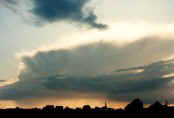| * ML50 CAPE = conservative
estimate of CAPE, lifting an average parcel in the bottom 50 hPa of a
sounding. This value can be found via soundings of
Wyoming.
Maps of forecasted CAPE on the internet = surface-based CAPE (or SBCAPE) which starts in lowest 2 meter.
Convert SBCAPE to ML50 CAPE with estimation table:
| SBCAPE |
ML50 CAPE |
Factor |
| 10 |
0.6 |
0.06 |
| 20 |
1.6 |
0.08 |
| 50 |
5.5 |
0.11 |
| 100 |
14 |
0.14 |
| 200 |
36 |
0.18 |
| 500 |
130 |
0.26 |
| 1000 |
330 |
0.33 |
| 1500 |
585 |
0.39 |
| 2000 |
880 |
0.44 |
| 2500 |
1175 |
0.47 |
| 3000 |
1500 |
0.50 |
| 4000 |
2240 |
0.56 |
| 5000 |
3100 |
0.62 |
BRN < 10: low risk severe thunderstorms.
BRN between 15 to 50: risk for supercells (upper teens are optimal)
BRN > 35: low risk for supercells, but risk for single cells or multicells.
The BRN is a better indictor of storm type than of storm
severity or storm rotation.
-Works best with CAPE between 1500-.3500 J/Kg
- CAPE < 1000 J/Kg and accompanied by moderate wind shear, the BRN
number may indicate supercells, but lack of buoyancy is likely to
inhibit severe weather occurrence.
-CAPE >3500 J/Kg with moderate wind shear, BRN values may suggest
multicells, but buoyancy energy will be sufficient to produce tornadoes
and large hail
Formula used: BRN = ML50 CAPE / (0,5 * U²)
(U = vector difference between 0-6km mean wind and 0-0,5km mean wind) |
